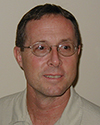 Richard W. Carlson |
2013 Day Medal
Presented to Richard W. Carlson
Citation by William K. Hart
Today it is my honor and pleasure to introduce Richard W. Carlson as the 2013 Arthur L. Day Medalist. During my time as Rick’s first post-doc it was clear to me that he had immense talents and I have been fortunate to benefit from many of these over our more than 30 years of friendship and collaboration.
Throughout his career Rick has tackled analytically and conceptually challenging geochemical and cosmochemical problems including nucleosynthetic isotope variability in early solar system materials; timescales and mechanisms of crust formation and mantle differentiation on the terrestrial planets; early Earth history; origin and tectonic implications of large-volume volcanism; and origin and evolution of the sub-continental mantle and its role in continent formation and preservation. Rick and his colleagues have been instrumental in developing techniques for high precision chemical and isotope analyses central to the research questions and subsequent advances. And for these accomplishments, he was recently inducted into the National Academy of Sciences. Moreover, in describing the impact of Rick’s extensive scientific contributions a colleague wrote; “Carlson’s careful work on these important problems has been seminal and inspirational to a new generation of geochemists who are using his discoveries as starting points for their own research.”
I recently asked Rick to summarize what he thought to be his most memorable research themes. Of these, two serve nicely to highlight the breadth and impact of his contributions; large Continental Dynamics projects and the 142-Neodymium story. Rick’s extraordinary scientific, technical, and organizational skills are at the core of successful large interdisciplinary endeavors such as the High Lava Plains and Kaapvaal CD projects. I marvel at his ability to integrate and synthesize data and ideas across disciplinary boundaries leading to creative new insights on complex problems. Rick’s creativity and technical savvy are no better illustrated than in his work with Maud Boyet demonstrating a difference in 142-Neodymium abundances between chondritic meteorites and the silicate Earth. Their landmark 2005 paper has spawned a number of other influential contributions providing explanations for this difference and implications for early Earth differentiation. I know that many in the solid Earth geochemistry and cosmochemistry communities agree that this series of papers may well represent the most important contributions to these disciplines in the past decade or more.
In closing, I am very pleased to have had this opportunity to share with you a snapshot of Rick Carlson’s exemplary professional accomplishments. I have nothing but praise for these accomplishments and echo the sentiment expressed by another of Rick’s colleagues who recently wrote “he is the most influential isotope geochemist on the scene today, both in terms of analytical acuity and research distinction”. Clearly this level of achievement is truly deserving of the Day Medal that recognizes “outstanding distinction in contributing to geologic knowledge through the application of physics and chemistry to the solution of geologic problems”. Rick, on behalf of those responsible for your Day Medal nomination and your other friends and colleagues, I sincerely congratulate you on this well-deserved award!
 2013 Day Medal — Response by Richard W. Carlson
2013 Day Medal — Response by Richard W. Carlson
Thanks very much for these kind words Bill, and for the many years of enjoyable collaboration. I feel incredibly honored to be awarded the Arthur L. Day Medal and thank my nominators and the evaluation committee of GSA for making this possible. I recognize the cliché in saying so, but I had absolutely no expectation of ever seeing my name in a list like that of the Day Medalists. Along with being an early President of the GSA, Arthur Day was the founding Director of the Geophysical Laboratory, my neighbor Department in the Carnegie Institution. We at Carnegie have a considerable advantage in the research arena because of the Institution’s focus on providing the perfect environment to conduct what was once, and, given the current sentiment in the US, likely will again be derisively called “curiosity based” science. I have little doubt that Carnegie’s support of its staff and its strong postdoctoral program truly are the reasons I am standing here today. Although I have a few first-authored papers, the good papers in my bibliography are written with the postdocs and visiting scientists with whom I have had the privilege to work throughout my career. I would like to read all their names, but if I did, I would have to enter my thousand words per minute rate of speech, for which a number of my less clear scientific presentations are well known. I would like to highlight a few, however. The Directors of my Department, first George Wetherill, then Sean Solomon and now Lindy Elkins-Tanton set an unmatched standard of scientific excellence and even-handed administration. In the lab, the stable support from Carnegie that allowed us to hire people like Mary Horan, Tim Mock and before them David Kuentz made it possible for me to concentrate on new techniques and approaches while being sure that the established methods would continue to be done at high quality. Among my long-term collaborators are Bill Hart, Steve Shirey, Graham Pearson, David James, Maud Boyet, and my advisors Gunter Lugmair and Doug Macdougall. How can one go wrong with associates like these? Finally, the colleague who has contributed in so many ways to my achievements is my wife of 15 years, Sonia Esperanca. Although my name will be entered into the list of Day Medalists, the achievements for which I’m being recognized would not have been possible without the contribution of these colleagues.
